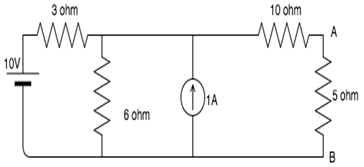1. The Norton current is the_______
A. Short circuit current
B. Open circuit current
C. Open circuit and short circuit current
D. Neither open circuit nor short circuit current
2. Norton resistance is found by?
A. Shorting all voltage sources
B. Opening all current sources
C. Shorting all voltage sources and opening all current sources
D. Opening all voltage sources and shorting all current sources
3. Norton’s theorem is true for __________
A. Linear networks
B. Non − Linear networks
C. Both linear networks and nonlinear networks
D. Neither linear networks nor non-linear networks
4. In Norton’s theorem Isc is__________
A. Sum of two current sources
B. A single current source
C. Infinite current sources
D. 0
5. It is found across the ____________ terminals of the network.
A. Input
B. Output
C. Neither input nor output
D. Either input or output
6. Can we use Norton’s theorem on a circuit containing a BJT?
A. Yes
B. No
C. Depends on the BJT
D. Insufficient data provided
7. Calculate the Norton resistance for the following circuit if 5 ohm is the load resistance.

A. 10 ohm
B. 11 ohm
C. 12 ohm
D. 13 ohm
8. Calculate the short circuit current is the 5 − ohm resistor is the load resistance.

A. 0.72A
B. 0.32A
C. 0.83A
D. 0.67A
9. Find the current in the 5 − ohm resistance using Norton’s theorem.

A. 1A
B. 1.5A
C. 0.25A
D. 0.5A
Answer: D
Shorting all voltage sources and opening all current sources we have:
RN = (3||6) + 10 = 12 ohm.
Since the 5 ohm is the load resistance, we short it and find the resistance through the short.
If we apply source transformation between the 6-ohm resistor and the 1A source, we get a 6V source in series with a 6-ohm resistor. Now we have two meshes.
Let us consider I1 flowing in the first mesh and I2 flowing in the second mesh.
The mesh equations are:
9I1 − 6I2 = 4
− 6I1 + 16I2 = 6
On solving these equations simultaneously, we get I2 = 0.72A, which is the short circuit current.
Connecting the current source in parallel to RN which is in turn connected in parallel to the load resistance = 5ohm, we get Norton’s equivalent circuit.
Using the current divider:
I = 0.72 × 12/(12 + 5) = 0.5 A.
[/bg_collapse]
10. Which of the following is also known as the dual of Norton’s theorem?
A. Thevenin’s theorem
B. Superposition theorem
C. Maximum power transfer theorem
D. Millman’s theorem
